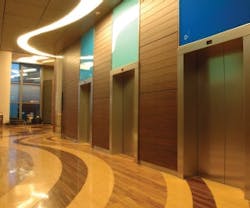Most decisions to modernize elevators are not triggered by the kind of simple necessity that requires immediate action. Instead building owners must decide not only how much to modernize but also when. And because modernization typically requires a significant investment, it pays to make a decision based on the business case supported by all the pertinent data.
"The decision to modernize is more of a business decision than a technical one. Clearly, today's technology is better than yesterday's," says Marc Cerniglia, principal with Collinsville, CT-based elevator consultant Ascent. "For most owners, the decision is strictly a financial one. Does it add value and how much?"
A building owner's time horizon for holding or selling a property is an obvious factor affecting the investment, but making a good decision that aligns with that horizon requires an in-depth understanding of the existing equipment.
If a solid maintenance plan has been in place, and survey work and data collection have been done on a regular basis, then information will be available to guide the decision. The service contract should list quantifiable performance metrics that the contractor must track, including floor-to-floor travel time, vibration and ride quality measures, noise levels, door closing times, and passenger response times.
Maintaining a rolling 12-month history of service calls is also valuable, according to Cerniglia. Looking at the bigger picture helps to determine whether an increase in calls is merely a random event tied to special circumstances in a building or whether it is a developing systemic condition that requires a timely response.
Weighing Obsolescence
Obsolescence drives many modernization decisions, and it includes declining availability of replacement parts as well as availability of service talent. Service personnel who know how to maintain a previous generation's elevator equipment may be fading away due to retirement.
Due to consolidation in recent years among elevator manufacturers and corresponding decisions to replace or discontinue certain equipment, the availability of parts can vary significantly, according to Scott Shepler, executive vice president of operations for elevator consultant Lerch Bates. Some manufacturers are known for maintaining a parts inventory longer than others. Moreover, the timeframe for obsolescence is becoming shorter for some equipment. "The new microprocessor boards and the sold state gear tend to have shorter life spans than the older relay logic equipment," Shepler says.
Because an OEM is likely to be best informed on maintaining equipment reaching the end of its service life, Shepler says an owner may be better served by a maintenance contract with the OEM. This may also be true when equipment is new and software and other updates are automatically available from the OEM.
The Best Option Based on a Hold or Sell Strategy
In theory, the hold or sell strategy of the owner for a particular property is an easy way of slicing through modernization options. To remain competitive for the long term in a hot market, it may be important to have all the latest features in a modernization package. Conversely, for a property that may soon be put on the market, the owner may want to keep the modernization investment as low as possible. In practice, things may not be so simple.
As an example, Shepler cites a building with 1980s-era elevators that was having a number of problems related to an older controller that combined solid state and relay logic components. The elevators were not always stopping at the right floors, adjustments were difficult, and maintenance personnel familiar with the equipment were dwindling. Because the ownership anticipated the possibility of selling over the next several years, it was inclined to undertake a less costly and less comprehensive modernization.
However, this option would not fully resolve the elevators' reliability issues, and might result in dollars being taken off the top in a prospective buyer's due diligence process. Moreover, Shepler explains that the new point-to-point wiring required for the limited option would soon need to be replaced by serial wiring when more controller updates would inevitably be needed to resolve all the issues – a case of paying twice for wiring. In this case, Shepler says the owner ultimately elected the costlier, comprehensive option.
"Modernization is like going on a diet. It's not just losing the weight – can you keep it off?" adds Cerniglia.
Chris Olson is chief content director of BUILDINGS.
